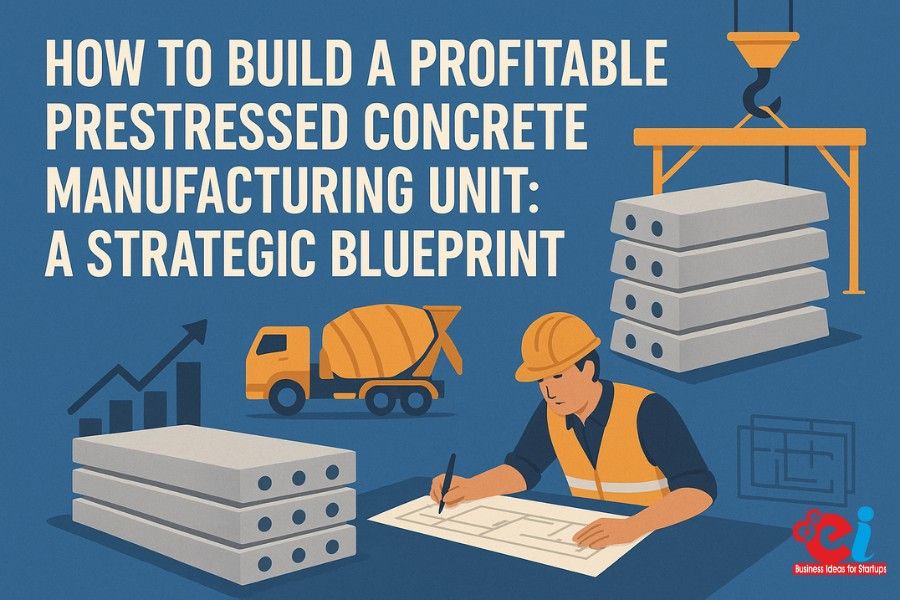Strengthening the Backbone of Modern Railways
The development of global railway infrastructure has been aided by the invention of Prestressed Concrete Sleepers . These robust and durable components are able to withstand cross-axial and environmental train impacts. As countries develop high-speed rail corridors, expand their metros, and increase heavy freight lines, the supply of prestressed concrete sleepers has to increase. In India, the growing web of railway modernization plans being developed by the Indian Railways, Dedicated Freight Corridors DFCs, and metros developed by state governments is fueling the demand for concrete sleepers. This concrete sleeper demand provides a new business opportunity for entrepreneurs and infrastructure builders to set up fully owned concrete sleeper factories with modern automated systems that enhance quality and volume standards.
The International Importance of Prestressed Concrete Sleepers
Special moulds are used to manufacture prestressed concrete sleepers with high-tensile steel wires. This component undergoes a preloading process also known as tensioning, where concrete is poured into moulds. This means that the concrete is capable of enduring compressive and tensile forces which greatly reduces the chances of cracking under the dynamic force of operating rail loads. Compared to timber or steel which has know rot and corrode, PSC sleepers resist deformation, providing more durability along the lifecycle costs. This makes them ideal for urban and intercity rail networks.
The domestic demand has exceeded 15 million units annually. This is a result of the Indian government investing in modernisation, rail electrification and expanding rail connectivity. There is also an increasing demand in developing African, South-East Asian and Latin American countries, deeming infrastructure expansion as a main priority. Therefore, these markets have long term prospects which are beneficial for establishing sleeper plants geared for both international and international consumers.
Comprehending the Manufacturing Moving Steps
The creation of prestressed concrete sleepers is an exacting manufacturing process that requires specific engineering procedures to be followed. It starts with the fabrication of steel molds that need to be scrubbed and oiled. The high-tensile steel wires or strands are then stretched and tensioned using hydraulic jacks. These strands are held at both ends to maintain the tension while the tailored concrete is filled in the mould.
The concrete mix must satisfy requirements pertaining to workability, strength and stress parameters. It is put on top the mounds over the strands with pretension and the set strands. Once poured, the steam curing chambers are used to allow the pretensioned concrete to cure. After the wanted compressive strength is achieved, which usually ranges from 24-48 hours post curing with concrete, the tension is released. The process induces condition which is prestressed to the sleeper, allowing greater effectiveness under load. Finally, the sleepers undergo a test to check if they meet the quality standards set, and the passed ones are then allowed to cure to fully remove the molds and let them rest.
Related: Prestressed Concrete Sleepers: Vital for Modern Railway Systems
Plant Infrastructure and Consideration for Layout
The design of civil, mechanical, and process engineering encompasses the construction of a PSC sleeper plant. The facility configuration should be close to the sources of cement and aggregates, as well as to railway sidings for peripheral routes, to reduce transportation costs. The concrete batching plant, steel strand storage, curing facilities, and testing laboratories are the subdivisions.
Efficiency in material handling, with the use of gantry cranes, conveyor lines, and mechanized demoulding stations, improves the productivity and safety of workers at a sleeper plant. To maintain uniformity in the output of a plant with high production volumes, the prestressing equipment’s jacks and hydraulic tensioning tools must be dependable and precise. Improvements in the quality and repeatability of processes and products are achieved through reducing manpower needed for tasks such as batching concrete, tensioning strands, and stacking sleepers, which is made possible by automation.
Raw Material Requirements and Sourcing Strategy
In order to guarantee strength, durability, and performance, prestressed concrete sleepers requires quality materials. The primary inputs include ordinary Portland cement of 53 grade or its equivalents, clean river sand or manufactured sand, crushed stone aggregates of specified size, and high-tensile steel wires or strands. Additional materials such as cast iron inserts for rail fastenings, chemical admixtures, curing water, etc., also need to comply with the specified technical standards.
Focus on distance from the source and reliability of supply is important, as well as adherence to regulations. Usually, cement and aggregates are available from local suppliers. Prestressing steel, however, comes from more specialized fabricators holding BIS certification or equivalent foreign certifications. Materials are usually acquired on a bulk basis under long-term contracts to mitigate input costs fluctuations and buildlem uninterrupted shaft production.
Quality Control and Regulatory Compliance
The degree of sensitivity placed on processes involving the manufacturing of PSC sleepers is high due to the potential client being Indian Railways as well as other international operators. Each sleeper has to fall within certain dimensions of tolerancing limits along with other compressive strength and prestress loss parameters set by either RDSO (Research Designs and Standards Organization) if in India, or UIC/EN standards abroad.
In addition to operating a quality control lab, the plant must perform slump testing, compressive strength testing, and transfer length measurement on-site. Each batch of sleepers receives random destructive and non-destructive testing. The surface finish on the sleeper, geometry of the rail seat, bonding of the inserts, and potential cracking are all evaluated with a high degree of accuracy and precision. All test results must be kept and provided to the quality control inspectors of the railway authorities. This ensures that all production lots are fully documented, audited, and traceable down to the individual parts and composite item constituents.
Investment Breakdown and Financial Returns
Setting up a PSC sleeper plant capable of producing 500 to 1000 units per day is estimated to incur a capital expenditure ranging from ₹15 to ₹25 crore. This includes expenditures on land preparation, factory building, equipment and machinery leasing, curing systems, plant automation, and working capital. Additional spending may be needed to gain RDSO accreditation and required safety features if supplying to government sponsored projects.
While the capital investment is still significant, the returns are promising. Depending on location, technology adoption, and client base, a sleeper plant might earn EBITDA margins of 18% to 25% per unit. Plants with direct government supply or BOOT (Build-Own-Operate-Transfer) contracts with metro authorities or logistics parks have guaranteed cash flows. Additionally, export-oriented units in India can further increase profitability through dollar-denominated contracts and lower raw material expenses.
Related: Start Prestressed Concrete Sleepers Manufacturing in India
Market Demand and Strategic Clients
Indian Railways, metro rail projects, private industrial sidings, and the development of logistics corridors has made India the highest consumer of prestressed concrete sleepers in the world. Private sector construction companies also supply things like bridges over railways, freight terminals, and depot lines that require a consistent supply of concrete sleepers.
That said, there is an increase in international demand as well. Indian manufactures are extremely cost effective and produce quality PSC sleepers for countries looking to invest in new railroad infrastructure like Ethiopia, Kenya, Bangladesh, Myanmar, and Vietnam. Establishing connections with export agencies, EPC contractors, and rail consultants create a steady supply for new plants.
Opportunities for Digitalization and Automation
The recent advancement of sleeper plant technology seeks to improve productivity while reducing human errors, which has led to the increased use of automation. Automated concrete batching, digital prestress monitoring, sleeper tracking using RFID tags, and real-time monitoring of curing temperatures all improve output and compliance.
Advanced ERP systems allow for monitoring of raw material consumption, compliance with quality standards, employee attendance, maintenance schedules, and delivery logistics. Increased use of modern digital tools can drive process variation and scrap rate reduction, which would improve profitability and contract compliance.

























